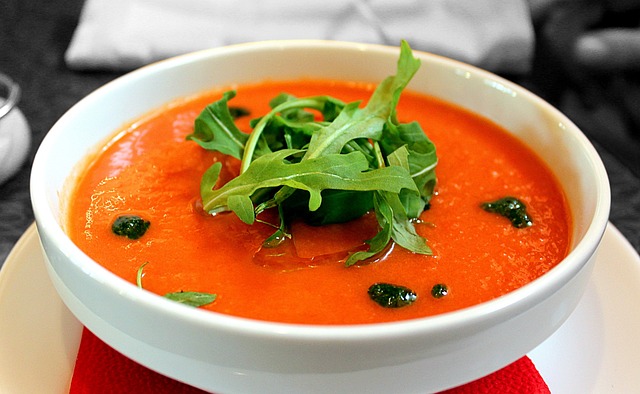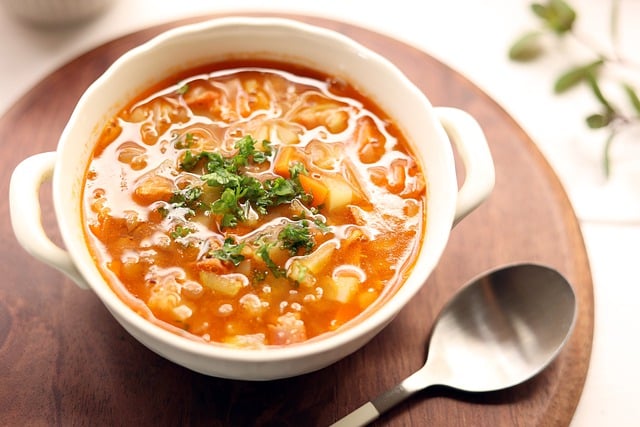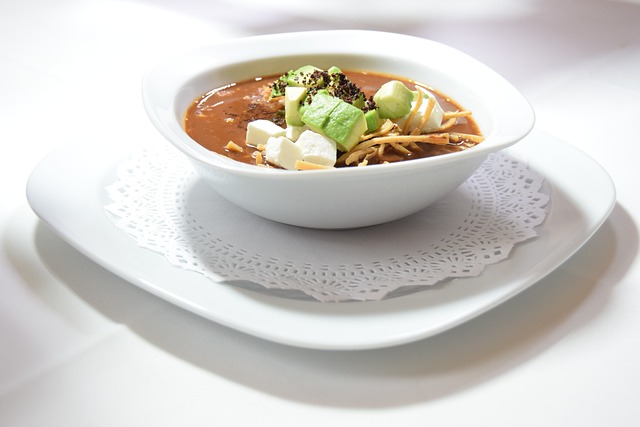The soup recipies special attention while discussing a food group that is consumed in almost every nation on earth. It all started with the discovery of fire and the ability to prepare foods like meat and vegetables. Since each location has contributed its own flavors and ingredients to this preparation, the history of soups is inextricably linked to the history of humanity.
Despite the enormous variety of recipes found around the world, soups all share the same intrinsic quality of comfort and welcome. If you enjoy this iconic meal as well, we welcome you to explore 8 popular soup recipies from around the world.
The Most Famous Soup Recipies In The World:
The world is home to a wide variety of soup recipies, each with its own unique flavors and cultural significance. While opinions on the “most famous” soups may vary, here are ten soup recipies that are widely known and enjoyed around the world:
1. Gazpacho (Spain):

Gazpacho is a chilled soup originating from Spain, particularly the Andalusia region. It is typically made with ripe tomatoes, cucumbers, bell peppers, garlic, onions, olive oil, vinegar, and bread. The ingredients are blended together to create a refreshing and tangy soup, often served with garnishes like croutons, diced vegetables, or herbs.
Gazpacho is particularly popular during the hot summer months as it provides a cool and revitalizing culinary experience.
2. Harira (Morocco):
Harira is a traditional Moroccan soup that holds cultural and religious significance, especially during the month of Ramadan. It is a hearty and aromatic soup made with a base of tomatoes, lentils, chickpeas, and various spices like ginger, turmeric, and cinnamon.
Harira often includes meat (such as lamb or beef), vegetables, and herbs. It is commonly enjoyed as the first meal to break the daily fast during Ramadan, accompanied by dates and other traditional foods.
3. Laksa (Malaysia and Singapore):

Laksa is a popular noodle soup found in both Malaysia and Singapore. There are various regional variations, but the dish typically consists of rice noodles in a flavorful, spicy coconut curry broth.
It is often garnished with ingredients like shrimp, tofu puffs, bean sprouts, boiled eggs, and fresh herbs. Laksa has a rich and complex flavor profile, combining elements of Chinese, Malay, and Indian cuisine.
4. Yayla çorbası (Turkey):
Yayla çorbası is a traditional Turkish yogurt soup. It is a creamy and tangy soup made with strained yogurt, chicken or vegetable broth, and rice.
Often flavored with dried mint and sometimes infused with lemon, yayla çorbası is enjoyed both as a starter and a main course. It is commonly garnished with fresh herbs like dill or parsley and served warm.
5. Minestrone (Italy):

Minestrone is a classic Italian vegetable soup known for its abundance of ingredients and hearty nature. The soup typically includes a variety of seasonal vegetables, such as tomatoes, carrots, beans, zucchini, onions, and celery. It is often cooked in a flavorful broth, sometimes with the addition of pasta or rice.
Minestrone is highly customizable and can vary from region to region, but it is universally recognized for its nourishing and comforting qualities.
6. Tom Yum (Thailand):
Tom Yum is a popular Thai soup known for its spicy and sour flavor profile. It is typically made with a fragrant broth infused with lemongrass, kaffir lime leaves, galangal, and chili peppers.
Tom Yum can feature various proteins such as shrimp, chicken, or tofu, and is often enriched with mushrooms, tomatoes, and herbs. The balance of spicy, sour, and aromatic elements makes Tom Yum a distinctive and beloved soup in Thai cuisine.
7. Tortilla Soup (Mexico):

Tortilla soup is a flavorful Mexican soup made with tomato and chili-based broth. It typically includes strips of fried or baked tortillas, as well as ingredients like chicken, avocado, cheese, and lime juice. The soup is often garnished with fresh cilantro, diced onions, and sometimes sour cream.
Tortilla soup offers a combination of textures and flavors, combining the richness of the broth with the crunchiness of tortilla strips.
8. Caldo Verde (Portugal):
Caldo Verde is a traditional Portuguese soup that originated in the northern region of the country. It is a simple yet delicious soup made with potatoes, kale or collard greens, onions, garlic, and olive oil.
The soup is typically flavored with chorizo or smoked sausage, which adds a savory and smoky element to the dish. Caldo Verde is often served with crusty
Healthy Soup Recipies:
There are several soups that can be beneficial for your health, as they provide essential nutrients and can be a great way to incorporate vegetables, lean proteins, and whole grains into your diet. Here are a few examples:
1. Vegetable Soup:
A homemade vegetable soup can be packed with vitamins, minerals, and fiber. Include a variety of vegetables like carrots, broccoli, bell peppers, spinach, and tomatoes for a nutritious option.
2. Chicken Noodle Soup:
This classic soup is often recommended for its soothing properties when you’re feeling under the weather. It typically contains chicken, vegetables, and noodles, providing protein, vitamins, and carbohydrates.
3. Lentil Soup:
Lentils are a great source of plant-based protein and dietary fiber. Lentil soup can be a hearty and nutritious option, as it also includes vegetables and spices. It’s filling and may help regulate blood sugar levels.
4. Tomato Soup:
Made from tomatoes, this soup is rich in antioxidants like lycopene, which has been associated with various health benefits. Opt for a low-sodium version or prepare it at home to control the ingredients.
5. Miso Soup:
A traditional Japanese soup made from fermented soybeans, miso soup is known for its probiotic content. It provides beneficial bacteria for gut health and is often enjoyed with tofu and seaweed.
It’s worth noting that the nutritional content of soups can vary depending on the ingredients and preparation methods. If you’re watching your sodium or calorie intake, consider preparing homemade soups using fresh ingredients or look for reduced-sodium options when purchasing pre-packaged soups.
What Are The Best Things To Put In Soup Recipies?
When it comes to making delicious soup, the possibilities are virtually endless. The ingredients you choose will depend on your personal taste preferences and the type of soup you’re aiming to create. However, here are some popular and versatile ingredients that you can consider adding to your soup:
1. Vegetables:
Carrots, celery, onions, garlic, bell peppers, mushrooms, tomatoes, potatoes, leeks, spinach, kale, corn, peas, and zucchini are commonly used vegetables in soups. They add flavor, texture, and nutrients.
2. Protein:
Chicken, beef, pork, turkey, shrimp, fish, tofu, lentils, beans (such as black beans, kidney beans, or chickpeas), and sausage can all be great sources of protein in soup. They can be cooked and added to the soup or simmered in the broth for flavor.
3. Broth:
Vegetable, chicken, beef, or seafood broth forms the base of many soup recipies. You can use store-bought or homemade broth, depending on your preference. Broth provides a flavorful foundation for the soup.
4. Herbs And Spices:
Fresh or dried herbs like thyme, basil, rosemary, parsley, cilantro, and bay leaves can enhance the taste of your soup. Spices such as cumin, paprika, turmeric, curry powder, and black pepper can also add depth and warmth.
5. Grains And Pasta:
Rice, noodles, pasta, barley, quinoa, or couscous can be added to make the soup more substantial and filling. They can also provide a nice texture.
6. Dairy Or Non-Dairy Additions:
Cream, milk, coconut milk, or yogurt can be used to add creaminess and richness to certain soup recipies. Non-dairy alternatives like almond milk or coconut cream can be used as well.
7. Garnishes:
Fresh herbs, grated cheese, croutons, sliced green onions, sour cream, chopped nuts, or a drizzle of olive oil can be used as toppings or garnishes to add an extra burst of flavor and visual appeal.
Is It Ok To Eat Soup Everyday?
Eating soup every day can be part of a healthy diet, depending on the ingredients and nutritional composition of the soup. soup recipies can be a great way to incorporate a variety of vegetables, legumes, and lean proteins into your meals. They can be low in calories, high in fiber, and provide essential nutrients.
However, it’s important to consider the specific type of soup you’re consuming. Some soup recipies may be high in sodium, saturated fats, or added sugars, which can be less healthy if consumed excessively.
Canned or processed soups often contain higher levels of sodium, so it’s beneficial to choose homemade or low-sodium options whenever possible.
Additionally, if you rely solely on soup as your primary source of nutrition, you may miss out on certain nutrients that are necessary for a well-rounded diet. It’s important to ensure you’re getting a balanced intake of protein, carbohydrates, healthy fats, vitamins, and minerals from other food sources as well.
Conclusion:
While soup can be a satisfying and nutritious meal, it’s important to ensure that it’s not the sole focus of your diet. Incorporating a variety of food groups and nutrients is essential for overall health and well-being.
By combining soup recipies with other wholesome foods, you can create a well-rounded and balanced diet that promotes optimal nutrition.
Ultimately, soup recipies offer a world of culinary possibilities, allowing you to explore different flavors, textures, and ingredients. Whether you’re looking for a comforting meal on a chilly day or a light and refreshing option during the warmer months, soup recipies can be a nourishing and enjoyable addition to your dining table.










